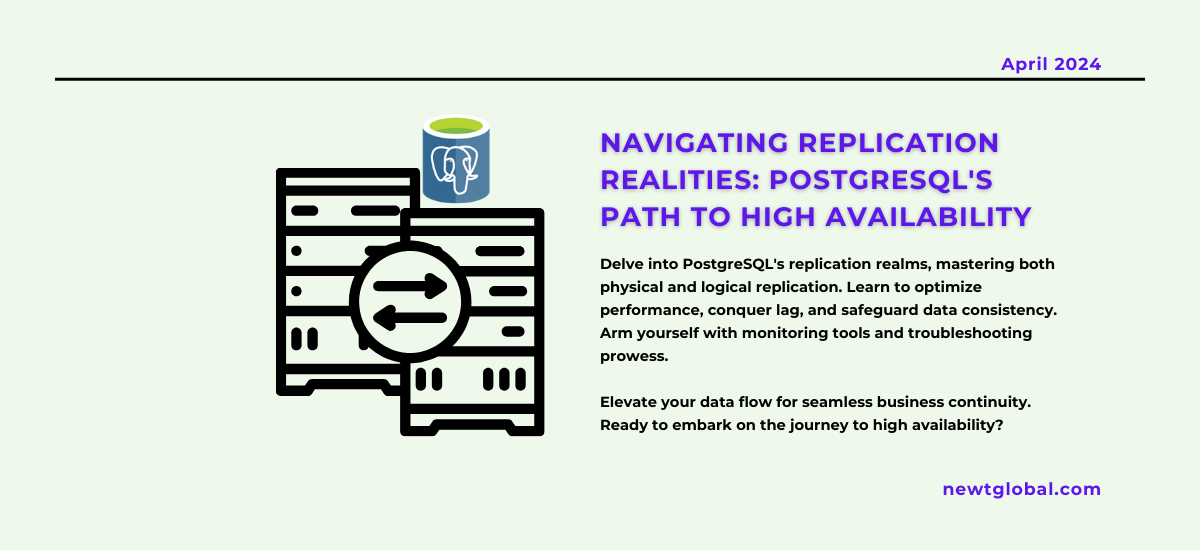
In the world of managing data, making sure that data is always available and can move smoothly is crucial for a business to keep running smoothly. PostgreSQL is a strong choice for this because it has powerful ways to copy data, called replication. This blog post dives into how PostgreSQL’s replication works, both physically and logically, and shares strategies to make replication faster, reduce delays, make sure data stays consistent, and handle any challenges that come up easily.
Discovering PostgreSQL Replication
Let’s explore PostgreSQL replication, which has two main parts, and see how it can be customized to fit your data needs perfectly.
Physical Replication: Keeping Data Safe and Sound
-
- Overview: Learn how physical replication works—it’s like making an exact copy of your data bit by bit to make sure it stays accurate.
- Use Cases: Great for creating backup plans in case of disasters, setting up systems that stay running even if one part fails, and handling queries that don’t change data.
- How to Set Up: Understand how to use streaming replication, WAL files (which log changes before they’re applied), and choose between synchronous (real-time) or asynchronous (slightly delayed) replication to make sure your data stays safe.
Logical Replication: Flexibility in Action
-
- Overview: Explore logical replication, where changes are sent as specific commands, giving you more flexibility.
- Use Cases: Perfect for upgrading databases without interruptions, copying specific tables instead of everything, and managing multiple copies of your data.
- How to Set Up: Learn about creating slots, setting up publications and subscriptions (ways to share data), and enjoy the freedom to change your data’s structure and copy only what you need.
Making Replication Faster and More Efficient
Discover ways to speed up your replication by adjusting different settings and working with your environment:
-
- Better Network Connections: Overcome delays caused by slow connections and limited bandwidth to keep data flowing smoothly.
- Optimizing WAL Files: Adjust settings related to WAL files to balance speed and accuracy.
- Using Compression: Shrink data sizes with compression to speed up how fast data can be copied.
Reducing Delays and Keeping Data Accurate
Handle delays in data copying and ensure that data stays consistent:
-
- Finding the Source of Delays: Identify why data copying might be slow, like network issues or too much work on the main server.
- Strategies to Reduce Delays: Use techniques to speed up copying, such as adjusting settings and making queries run more efficiently.
- Keeping Data Accurate: Make sure that data stays consistent between your main and backup databases, so your information is always reliable.
Monitoring and Fixing Issues
Keep an eye on your replication system and fix any problems that come up:
-
- Tools for Monitoring: Use tools to check how well your replication is working, including tracking delays and making sure everything is running smoothly.
- Fixing Common Problems: Learn how to solve common issues, like when data copying falls behind or when settings aren’t quite right.
The Big Picture
Optimizing PostgreSQL replication for reliability is like navigating through unknown territory. By understanding both physical and logical replication, fine-tuning performance, and keeping a close watch on your system, you can make sure your data stays safe and supports your business needs well into the future.
Explore PostgreSQL replication to ensure your data stays available and moves smoothly. Learn about different types of replication, make replication faster, and handle any issues that might come up with expert strategies.
Ready to elevate your PostgreSQL replication game?
Explore advanced strategies and unleash the full potential of PostgreSQL with Newt Global’s DMAP. Experience seamless data management and faster migration from Oracle DB to cloud-native PostgreSQL. Contact us at marketing@newtglobalcorp.com or visit newtglobal.com to learn more. Remember, Newt Global DMAP is a world-class product enabling mass migration of Oracle DB to cloud-native PostgreSQL faster, better, and cheaper. Don’t wait, revolutionize your data management today!”
